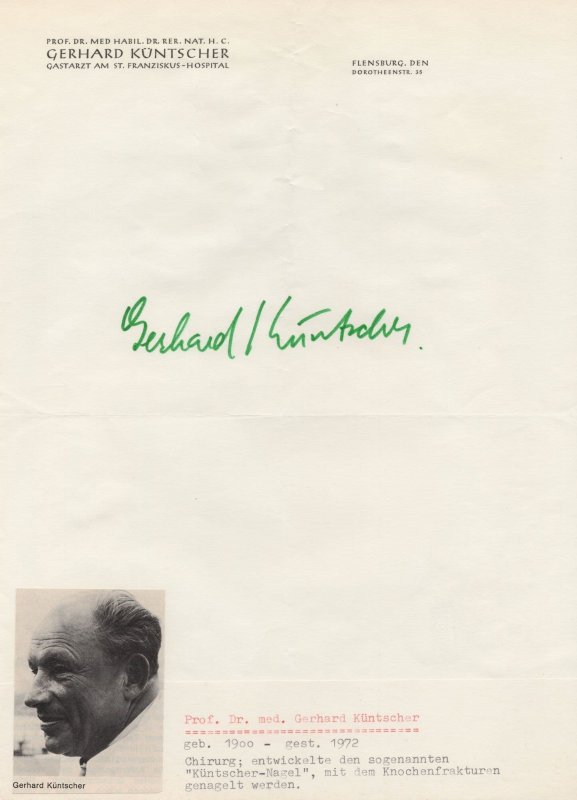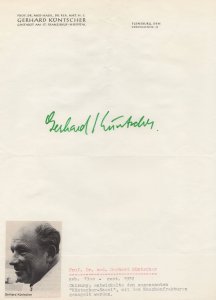ID: 50873126
Closed
This item is no longer available for sale.
Gerhard Kuntscher German Military WW2 POW Surgeon Signed Autograph
£39.99
Seller:
Postcard_Finder (7359)
CHAU2104 This is a large 10" x 8" hand signed autographed headed paper letter from Gerhard Kuntscher (6 December 1900 17 December 1972 (aged 72) who was a German surgeon who inaugurated the intramedullary nailing o ... Read More
CHAU2104 This is a large 10" x 8" hand signed autographed headed paper letter from Gerhard Kuntscher (6 December 1900 17 December 1972 (aged 72) who was a German surgeon who inaugurated the intramedullary nailing of long bone fractures. He has personally autographed the souvenir in bold green felt ink- please note the lower image is just from the album housing the autograph and not part of the listing - I have scanned it with the headed paper autograph for reference in case the German translates to something useful for the purchaser - It is folded twice where originally posted (which is how I will send) but in very good (and mostly otherwise great) condition.
_Küntscher invented what is known as the Küntscher nail, an internal fixation device used to maintain the position of the fracture fragments during healing. The nail is rigid and has a cloverleaf shape in cross-section. Küntscher first performed the process using the nail in November 1939 at the University Department of Surgery in Kiel. He first presented 12 cases of intramedullary fixation with rods at a surgical meeting in Berlin 03/18/40 and was met with general disapproval for using surgery for fractures. The German military initially disapproved of Kuntscher's IM nailing technique but introduced it in 1942. _
_While in the Finnish Lapland from 1942 to 1944, Küntscher taught Finnish surgeons to do intramedullary nailings, which earned him recognition and respect in the orthopedic community. The war also prevented the knowledge of Küntscher's use of the IM nail to exit Germany. The German military had the upper hand in treating soldiers with the IM nail and having them return to fighting status in just a few weeks. Worldwide knowledge was not established until the prisoners of war (POW's) returned to their home countries carrying Küntscher's legacy in the form of steel nails in their legs. _
_Returned POW's included airmen who had parachuted and broken femurs on landing. Künstscher had been reassigned to a Luftwaffe hospital outside of Berlin and Luftwaffe POW's were treated there. All previous treatment of femur fractures required 6 weeks of bed rest and Allied doctors debriefing the returnees were astonished that they were up and walking in days after surgery. A. W. Fischer, head of Küntscher's department, said in 1944 about his invention: "This practical treatment of fractures using a nail, the Küntscher procedure, is, in my eyes, the greatest revolution in the treatment of bone fractures since the invention of nail extension by Klapp, and this revolution will conquer the world_
_Küntscher invented what is known as the Küntscher nail, an internal fixation device used to maintain the position of the fracture fragments during healing. The nail is rigid and has a cloverleaf shape in cross-section. Küntscher first performed the process using the nail in November 1939 at the University Department of Surgery in Kiel. He first presented 12 cases of intramedullary fixation with rods at a surgical meeting in Berlin 03/18/40 and was met with general disapproval for using surgery for fractures. The German military initially disapproved of Kuntscher's IM nailing technique but introduced it in 1942. _
_While in the Finnish Lapland from 1942 to 1944, Küntscher taught Finnish surgeons to do intramedullary nailings, which earned him recognition and respect in the orthopedic community. The war also prevented the knowledge of Küntscher's use of the IM nail to exit Germany. The German military had the upper hand in treating soldiers with the IM nail and having them return to fighting status in just a few weeks. Worldwide knowledge was not established until the prisoners of war (POW's) returned to their home countries carrying Küntscher's legacy in the form of steel nails in their legs. _
_Returned POW's included airmen who had parachuted and broken femurs on landing. Künstscher had been reassigned to a Luftwaffe hospital outside of Berlin and Luftwaffe POW's were treated there. All previous treatment of femur fractures required 6 weeks of bed rest and Allied doctors debriefing the returnees were astonished that they were up and walking in days after surgery. A. W. Fischer, head of Küntscher's department, said in 1944 about his invention: "This practical treatment of fractures using a nail, the Küntscher procedure, is, in my eyes, the greatest revolution in the treatment of bone fractures since the invention of nail extension by Klapp, and this revolution will conquer the world_
Seller Information
- Seller
- Postcard_Finder (7359)
- Registered Since
- 01/12/2017
- Feedback
- 99.9%
- Store
- Postcard_Finder
Sales History
The listing has not been sold.
- Item Location
- Norfolk, United Kingdom
- Ships To
- Worldwide
Postage Calculator
- Select Country
- Quantity
- Shipping Instructions
- All Items = 2.50p to UK customers - £4.95 worldwide - Free postage on all extra selections after first item ALL ITEMS SHIPPED IMMEDIATELY BY PRIORITY SERVICES.
- Returns Accepted
- Yes
- Returns Policy
- All returns accepted - Buyer pays return costs - Item refunded on same day receipt
You need to be logged in to ask the seller a question.
Click here to login
Click here to login
Listing viewed 2 times
Listing watched by 0 users

